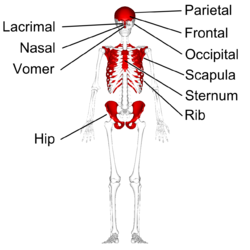
Back Platbeen Afrikaans عظم مسطح Arabic Яҫы һөйәк Bashkir Platter Knochen German Os plat French Kości płaskie Polish Os plat Romanian Плоские кости Russian Xương dẹt Vietnamese
| Flat bone | |
|---|---|
 Anatomy of a flat bone (Frontal bone) | |
 Flat bones in human skeleton. (shown in red) | |
| Details | |
| Identifiers | |
| Latin | os planum |
| TA98 | A02.0.00.013 |
| TA2 | 371 |
| FMA | 7476 |
| Anatomical terms of bone | |
Flat bones are bones whose principal function is either extensive protection or the provision of broad surfaces for muscular attachment. These bones are expanded into broad, flat plates,[1] as in the cranium (skull), the ilium, ischium, and pubis (pelvis), sternum and the rib cage. The flat bones are: the occipital, parietal, frontal, nasal, lacrimal, vomer, sternum, ribs, and scapulae.[1]
These bones are composed of two thin layers of compact bone enclosing between them a variable quantity of cancellous bone,[1] which is the location of red bone marrow. In an adult, most red blood cells are formed in flat bones. In the cranial bones, the layers of compact tissue are familiarly known as the tables of the skull; the outer one is thick and tough; the inner is thin, dense, and brittle, and hence is termed the vitreous (glass-like) table.[1] The intervening cancellous tissue is called the diploë, and this, in the nasal region of the skull, becomes absorbed so as to leave spaces filled with air–the paranasal sinuses between the two tables.[1]
© MMXXIII Rich X Search. We shall prevail. All rights reserved. Rich X Search